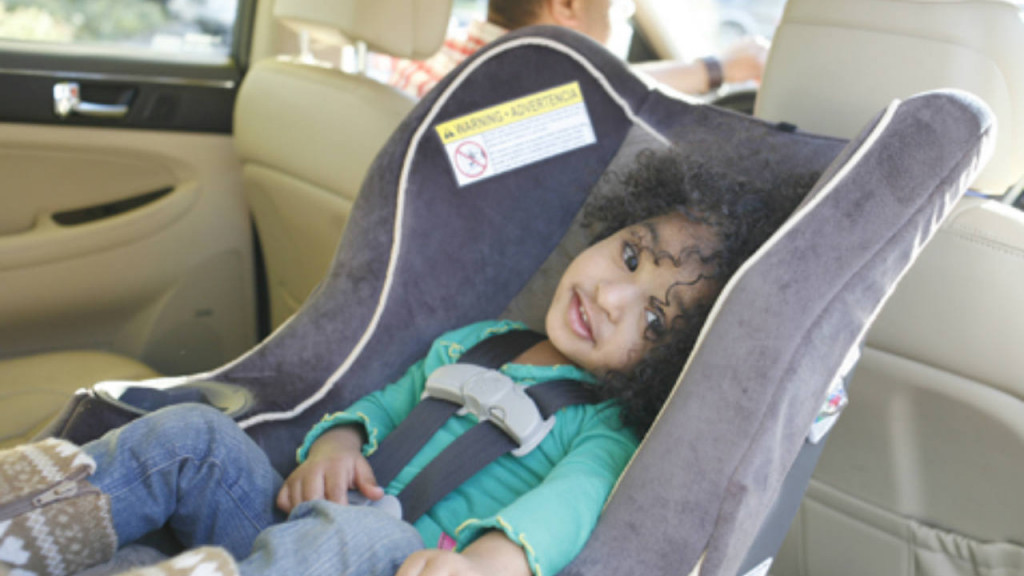
Photo: NHTSA IMAGE LIBRARY
It’s an issue many parents grapple with: When should you turn your kid’s car seat forward-facing? The American Academy of Pediatrics (AAP) has released an important new policy on this that can help guide you through this decision.
Previously the organization specified that kids should remain rear-facing until age two. The new guidelines remove the age-specific milestone and instead state that children remain in a rear-facing car seat for “as long as possible, until they reach the highest weight or height allowed by their car safety seat’s manufacturer.”
Why the new car seat recommendation matters
“This is fantastic news,” says Sharalyn Crossfield, an Ottawa-based Child Passenger Safety Technician Instructor. “We know from statistics that kids aged 0-2 have higher injury numbers, and that’s because they’re coming out of rear-facing too soon.” (She adds that kids aged 8-12 also have higher injury numbers due to ditching their booster seats too soon.)
There’s no debate that sitting rear-facing is safer—stats and crash tests have proven it over and over again. The recommendation to keep kids rear-facing beyond age two “results from the need to support the young child’s posterior torso, neck, head and pelvis and to distribute crash forces over the entire body,” says the AAP. “Developmental considerations, including incomplete vertebral ossification, more horizontally oriented spinal facet joints, and excessive ligamentous laxity put young children at risk for head and spinal cord injury.”
How do rear-facing car seats address this risk? Mainly, they support a child’s head, preventing the relatively large head from moving independently of the proportionately smaller neck. That said, rear-facing is safer for adults, too. Crossfield, for one, always chooses to sit rear-facing on trains because she knows that in an event of a crash, her legs are likely to absorb the impact opposed to her spine.
Other countries have already figured this out. In Sweden, for example, almost all children sit facing the back way beyond age two. “Everyone does it there,” says Crossfield. “It’s not a law—they just all know it’s safer.”
Why do many parents move to forward-facing prematurely?
What’s behind North American parents’ big rush to switch to forward-facing as soon as they’re legally allowed? In Canada, Crossfield estimates that about 50% of parents turn their kids forward-facing even before age two. But why?
For Canadian parents, one reason may be that many follow the guidelines set out by provincial and federal governments, and medical organizations—which, says Crossfield, are woefully outdated. For example, the Canadian Paediatric Society’s (CPS) position on this issue is that rear-facing car seats should be used “until children weigh at least 10 kg (22 lb), and are at least one year of age and able to walk.” Similarly, the Transport Canada website states that “children who have outgrown their rear-facing seat and weigh at least 10 kg (22 lb) may ride facing the front in a child car seat.” Crossfield notes that, in rare cases, this could mean a four-month-old baby could be legally facing forward.
One the other hand, the same CPS page also notes that rear-facing infant/child restraints “may continue to be used beyond 10 kg and one year of age, in accordance with the manufacturer’s instructions for height and weight limitations” and that “parents should be encouraged to continue to use a rear-facing seat as long as the height and weight limitations allow.” The Transport Canada website echoes this: “Keep your child seated rear-facing until he or she reaches the child car seat’s weight or height limits.” And Jen Shapka, a Child Passenger Safety Technician Instructor Trainer and co-author of the national CPST training program with the Child Passenger Safety Association of Canada, notes that there are more and more car seats available in Canada at an affordable price point with a height and weight limit that allows kids to stay rear facing for longer than ever.
Another reason parents are turning their kids too soon is because they lack a solid understanding of how collisions work. “Their biggest fear is their kid’s legs breaking,” says Crossfield. But they might not realize that the alternative is a broken spine or head injury.
Parents also turn their kid’s seat prematurely because they think their kids don’t like facing the back, they get car sick, or it’s more convenient. These things may be true—but do any of them actually trump safety? And the idea that friends or family members turned their kids forward facing at a young age and “they turned out fine” isn’t the strongest argument. Arguably, children who aren’t vaccinated may also turn out fine, but we nonetheless vaccinate our kids because it’s better to be safe than sorry.
Some parents report that their kid screams, cries and throw up when rear-facing, and that the disruption causes parental distraction, putting the whole family at a higher risk of collision. “In a small percentage of cases I think that could be true,” says Shapka. But she nonetheless strongly encourages finding ways to make changes in the vehicle to make your child happier and more comfortable while still rear-facing. Don’t let a few screaming sessions make the decision for you. “Your child doesn’t get to make safety decisions for themselves,” she says.
When’s the optimal time to switch to a forward-facing car seat?
Both Shapka and Crossfield say there’s generally no reason kids can’t stay rear-facing until around age four. If that sounds ludicrous, it’s because our government’s policies and society’s general knowledge simply hasn’t caught up to the science, they say. The fact is, nobody thinks a terrible car crash will happen to them if they’ve never been in one.
The issue is still cloudy
Although she’s “excited” by the AAP’s new guidelines, Shapka also has some concerns. “With the specific age removed, it makes it more broad for parents,” she says. “Age two, while potentially not as long as we’d want, was an easy milestone to watch for. I’m concerned that removing the number will confuse people.” In other words, while the AAP’s goal is to keep kids in rear-facing seats beyond age two, she’s worried this could result in kids turning around sooner than ever. The onus is on parents to stay up to date and informed with issues related to their kids’ safety.
Read more:
This ‘genius’ car seat hack can actually put your child at more risk
Canadian car seat reviews (2018)
 Baby Heath and Care Advice and Tips AXJ HEALTH GLOBAL NEWS NETWORK
Baby Heath and Care Advice and Tips AXJ HEALTH GLOBAL NEWS NETWORK









